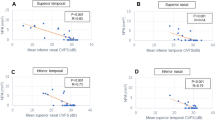Abstract
Purpose
To evaluate the relationship between retinal haemorrhages detected on Ultra-widefield (UWF) red channel images and perfusion status in eyes with acute central retinal vein occlusion (CRVO).
Methods
UWF fundus images were split into green and red channels using ImageJ software. The retinal haemorrhages were calculated quantitatively with both the green and red channel images, resulting in green channel haemorrhages (GCH) and red channel haemorrhages (RCH). The nonperfusion area (NPA) was also calculated from fluorescein angiography in each eye. The relationships between both the GCH and RCH with the NPA were investigated.
Results
Thirty-two eyes of 32 patients with acute CRVO (18 men, 14 women) were included. The mean GCH and RCH values were 10.4% ± 8.2% and 1.7% ± 1.7%, respectively. The mean NPA was 39.2% ± 28.8%. Significant correlations were seen between the GCH and NPA (r = 0.38; P = 0.022) and RCH and NPA (r = 0.44; P = 0.010, linear regression analysis). Multivariate analysis suggested that only the RCHs were correlated significantly with the NPA.
Conclusions
Retinal haemorrhages detected by UWF red channel imaging were less compared to green channel imaging and associated closely with retinal NPAs in eyes with acute CRVO.
UWF red channel imaging allowed us to identify ischaemia-related haemorrhage.
This is a preview of subscription content, access via your institution
Access options
Subscribe to this journal
Receive 18 print issues and online access
$259.00 per year
only $14.39 per issue
Buy this article
- Purchase on Springer Link
- Instant access to full article PDF
Prices may be subject to local taxes which are calculated during checkout


Similar content being viewed by others
Data availability
The datasets generated during and/or analysed during the current study are available from the corresponding author (ST) on reasonable request.
References
Natural history and clinical management of central retinal vein occlusion. The central vein occlusion study group. Arch Ophthalmol. 1997;115:486–91.
McIntosh RL, Rogers SL, Lim L, Cheung N, Wang JJ, Mitchell P, et al. Natural history of central retinal vein occlusion: an evidence-based systematic review. Ophthalmology. 2010;117:1113–23. e1115.
Hayreh SS, Podhajsky PA, Zimmerman MB. Natural history of visual outcome in central retinal vein occlusion. Ophthalmology. 2011;118:119–33. e111-112.
Baseline and early natural history report. The central vein occlusion study. Arch Ophthalmol. 1993;111:1087–95.
Hajdu D, Told R, Angeli O, Weigert G, Pollreisz A, Schmidt-Erfurth U, et al. Identification of microvascular and morphological alterations in eyes with central retinal non-perfusion. PLoS One. 2020;15:e0241753.
Sakimoto S, Gomi F, Sakaguchi H, Akiba M, Kamei M, Nishida K. Analysis of retinal nonperfusion using depth-integrated optical coherence tomography images in eyes with branch retinal vein occlusion. Invest Ophthalmol Vis Sci. 2015;56:640–6.
Hayreh SS, Zimmerman MB. Fundus changes in central retinal vein occlusion. Retina. 2015;35:29–42.
Muraoka Y, Uji A, Tsujikawa A, Murakami T, Ooto S, Suzuma K, et al. Association between retinal hemorrhagic pattern and macular perfusion status in eyes with acute branch retinal vein occlusion. Sci Rep. 2016;6:28554.
Muraoka Y, Uji A, Tsujikawa A, Murakami T, Ooto S, Suzuma K, et al. Association between retinal hemorrhagic patterns and perfusion status in eyes with acute central retinal vein occlusion. Retina. 2017;37:500–8.
Au A, Hilely A, Scharf J, Gunnemann F, Wang D, Chehaibou I, et al. Relationship between nerve fiber layer hemorrhages and outcomes in central retinal vein occlusion. Invest Ophthalmol Vis Sci. 2020;61:54.
Nagiel A, Lalane RA, Sadda SR, Schwartz SD. Ultra-widefield fundus imaging: a review of clinical applications and future trends. Retina. 2016;36:660–78.
Prasad PS, Oliver SC, Coffee RE, Hubschman JP, Schwartz SD. Ultra wide-field angiographic characteristics of branch retinal and hemicentral retinal vein occlusion. Ophthalmology. 2010;117:780–4.
Neubauer AS, Kernt M, Haritoglou C, Priglinger SG, Kampik A, Ulbig MW. Nonmydriatic screening for diabetic retinopathy by ultra-widefield scanning laser ophthalmoscopy (Optomap). Graefes Arch Clin Exp Ophthalmol. 2008;246:229–35.
Sato A, Asaoka R, Tanaka S, Nagura K, Tanaka Y, Arasaki R, et al. Using ultra-widefield red channel images to improve the detection of ischemic central retinal vein occlusion. PLoS One. 2021;16:e0260383.
Croft DE, van Hemert J, Wykoff CC, Clifton D, Verhoek M, Fleming A, et al. Precise montaging and metric quantification of retinal surface area from ultra-widefield fundus photography and fluorescein angiography. Ophthalmic Surg Lasers Imaging Retin. 2014;45:312–7.
Wykoff CC, Brown DM, Croft DE, Major JC Jr, Wong TP. Progressive retinal nonperfusion in ischemic central retinal vein occlusion. Retina. 2015;35:43–47.
Tsui I, Kaines A, Havunjian MA, Hubschman S, Heilweil G, Prasad PS, et al. Ischemic index and neovascularization in central retinal vein occlusion. Retina. 2011;31:105–10.
Author information
Authors and Affiliations
Contributions
ST, YT and TI were responsible for writing the report, conducting the search, extracting and analysing data, interpreting results, updating reference lists. KoN, RA, KO, ShoK, KeN and ShiK contributed to extracting data. YY, MI and KK provided feedback on the report.
Corresponding author
Ethics declarations
Competing interests
The authors declare no competing interests.
Additional information
Publisher’s note Springer Nature remains neutral with regard to jurisdictional claims in published maps and institutional affiliations.
Supplementary information
Rights and permissions
Springer Nature or its licensor (e.g. a society or other partner) holds exclusive rights to this article under a publishing agreement with the author(s) or other rightsholder(s); author self-archiving of the accepted manuscript version of this article is solely governed by the terms of such publishing agreement and applicable law.
About this article
Cite this article
Tanaka, S., Tanaka, Y., Inoue, T. et al. Retinal haemorrhages on ultra-widefield red channel images and perfusion status in central retinal vein occlusion. Eye 37, 2305–2309 (2023). https://doi.org/10.1038/s41433-022-02337-3
Received:
Revised:
Accepted:
Published:
Issue Date:
DOI: https://doi.org/10.1038/s41433-022-02337-3



